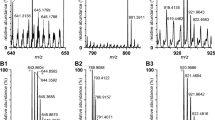Abstract
Characteristics of tryptic peptides that provide the detection and identification of these compounds and corresponding proteins by matrix-assisted laser desorption/ionization (MALDI) mass spectrometry with α-cyano-4-hydroxycinnamic acid as a matrix are determined and discussed. Twenty-five proteins are identified; the features of reliably identified peptides are compared to those of the compounds that might be produced by trypsinolysis but were not detected. Two key factors enhancing a possibility of the detection of tryptic peptides are determined. One refers to the basicity of peptides in the gas phase, which is the highest for peptides with the C-terminal arginine residue; this reason for the emergence of significant analytical signals is well known. Another factor contributing to the ionization of peptides in study under MALDI conditions is their hydrophilicity. This result did not correlate with the most conclusions of earlier relevant studies discussed in the article.





Similar content being viewed by others
REFERENCES
Aebersold, R. and Mann, M., Nature, 2003, vol. 422, no. 6928, p. 198.
Lebedev, A.T., Artemenko, K.A., and Samgina, T.Yu., Osnovy mass-spektrometrii belkov i peptidov (Fundamentals of Mass Spectrometry of Proteins and Peptides), Moscow: Tekhnosfera, 2012.
Suckau, D., Resemann, A., Schuerenbeig, M., et al., Anal. Bioanal. Chem., 2003, vol. 376, no. 7, p. 952.
Hillenkamp, E., Jaskolla, T.W., and Karas, M., in MALDI MS: A Practical Guide to Instrumentation, Methods, and Applications, Hoboken: Wiley, 2014, 2nd ed., p. 1.
Devenyi, T. and Gergely, J., Amino Acids, Peptides, and Proteins, Budapest: Akademiai Kiado, 1974.
Krause, E., Wenschuh, H., and Jungblut, P.R., Anal. Chem., 1999, vol. 71, no. 19, p. 4160.
Nishikaze, T. and Takayama, M., Rapid Commun. Mass Spectrom., 2006, vol. 20, no. 3, p. 376.
Couto, N., Barber, J., and Gaskell, S.J., J. Mass Spectrom., 2011, vol. 46, no. 12, p. 1233.
Nadlerr, W.M., Waidelich, D., Kerner, A., et al., J. Proteome Res., 2017, vol. 16, no. 3, p. 1207.
Kanda, F., Yoshida, S., Okumura, T., et al., Rapid Commun. Mass Spectrom., 1995, vol. 9, no. 12, p. 1095.
Kratzer, R., Eckerskorn, C., Karas, M., et al., Electrophoresis, 1998, vol. 19, no. 11, p. 1910.
Mallick, P., Schirle, M., Chen, S.S., et al., Nat. Biotechnol., 2007, vol. 25, no. 1, p. 125.
Timm, W., Scherbart, A., Böcker, S., et al., BMC Bioinf., 2008, vol. 9, no. 1, p. 443.
Milman, B.L., Lugovkina, N.V., and Zhurkovich, I.K., J. Anal. Chem., 2017, vol. 72, no. 14, p. 1411.
Frewen, B.E., Merrihew, G.E., Wu, C.C., et al., Anal. Chem., 2006, vol. 78, no. 16, p. 5678.
PeptideMass. https://web.expasy.org/peptide_mass. Accessed June 5, 2018.
PeptideCutter. https://web.expasy.org/peptide_cutter/peptidecutter_special_enzymes.html. Accessed June 5, 2018.
Sequence Manipulation Suite. http://www.bioinformatics.org/ sms2/index.html. Accessed January 10, 2018.
ProtParam. https://web.expasy.org/protparam. Accessed January 10, 2018.
Statistical Significance Calculator. www.easycalcula-tion.com/statistics/statistical-significance.php. Accessed January 10, 2018.
Gonnet, E., Lemaître, G., Waksman, G., et al., Proteome Sci., 2003, vol. 1, no. 1, p. 2.
Harrison, A., Mass Speetrom. Rev., 1997, vol. 16, no. 4, p. 201.
Paizs, B. and Suhai, S., Mass Spectrom. Rev., 2005, vol. 24, no. 4, p. 508.
Eichacker, L.A., Granvogl, B., Mirus, O., et al., J. Biol. Chem., 2004, vol. 279, no. 49, p. 50915.
Schlenzig, D., Manhart, S., Cinar, Y., et al., Biochemistry, 2009, vol. 48, no. 29, p. 7072.
Protein Cutter. https://software.cr-hana.upol.cz/proteincutter. Accessed May 9, 2018.
Torchinskii, Y.M., Sul’fgidril’nye i disul’fidnye gruppy belkov (Hydrosulfide and Disulfide Protein Groups), Moscow: Nauka, 1971.
ACKNOWLEDGMENTS
The results of protein identification obtained in the Laboratory of Biomedical and Pharmaceutical Mass Spectrometry of the Institute of Experimental Medicine were used. The authors are grateful to the colleagues in the Institute of Experimental Medicine, who provided relevant samples for analysis: Dr. Sci. T.V. Gupalova, Dr. Sci. A.V. Dmitriev, Ph. D. E.V. Kuleshevich, Dr. Sci. A.I. Orlov, M.D. A.N. Suvorov, and M. D. M.M. Shavlovskii. The authors are also grateful to Prof. M.M. Shavlovskii for valuable advice and Dr. Sci. O.V. Shamova for discussing the manuscript of the article and the critical comments made.
Funding
The work was performed within the framework of the State Assignment for Performing Fundamental Research in the Program for Basic Research in State Academies of Sciences for 2013–2020, Section 76 “Development of Molecular Profiling Methods for Predicting the Risks of Develo** Socially Significant Diseases.”
Author information
Authors and Affiliations
Corresponding author
Ethics declarations
The authors declare that they have no conflict of interest.
Additional information
Translated by O. Zhukova
Rights and permissions
About this article
Cite this article
Milman, B.L., Solov’eva, A.V., Lugovkina, N.V. et al. Features of Tryptic Peptides Providing Their Detection and Identification by MALDI Mass Spectrometry. J Anal Chem 74, 1286–1295 (2019). https://doi.org/10.1134/S1061934819130094
Received:
Revised:
Accepted:
Published:
Issue Date:
DOI: https://doi.org/10.1134/S1061934819130094




